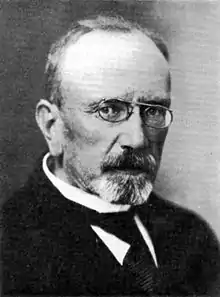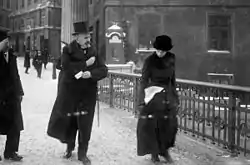Hjalmar Hammarskjöld
Knut Hjalmar Leonard Hammarskjöld (Swedish: [ˈjǎlmar ˈhâmːarˌɧœld]; 4 February 1862 – 12 October 1953) was a Swedish politician and scholar who was Prime Minister of Sweden from 1914 to 1917, and a Member of Parliament from 1923 to 1938 (first chamber).[1] He was the father of Dag Hammarskjöld, the second United Nations Secretary General from 1953 to 1961.
Hjalmar Hammarskjöld | |
|---|---|
 Hjalmar Hammarskjöld | |
| Prime Minister of Sweden | |
| In office 17 February 1914 – 30 March 1917 | |
| Monarch | Gustaf V |
| Preceded by | Karl Staaff |
| Succeeded by | Carl Swartz |
| Personal details | |
| Born | Knut Hjalmar Leonard Hammarskjöld 4 February 1862 Tuna, United Kingdoms of Sweden and Norway |
| Died | 12 October 1953 (aged 91) Stockholm, Sweden |
| Spouse | |
| Children | 4, including Åke and Dag |
Life and work
The son of lieutenant Knut Vilhelm Hammarskjöld, a noble, landowner and female line descendant of an illegitimate daughter of Eric XIV of Sweden, and wife Maria Lovisa Cecilia Vilhelmina Cöster, Hammarskjöld was born into the Hammarskjöld family in Tuna, Vimmerby, Kalmar County.
Hammarskjöld was a versatile legal expert and prominent as both a scholar and as a legislator. In 1891 he became a professor in Uppsala University and had a great influence on Swedish and Nordic civil law. He laid the foundation for his reputation as an expert in international law at the same time through diligent work in international meetings, and became a member of the Permanent Court of Arbitration in 1904 at The Hague. He was a participant at the Second Hague Peace Conference in 1907.[2]
In 1890, he married Agnes Maria Carolina Almquist (15 January 1866–21 January 1940). The couple had four sons: Bo, Åke, Sten and Dag.
As minister of justice from 1901 to 1902 in Fredrik von Otter's government he made an ambitious but unsuccessful attempt to resolve the problems concerning the right to vote, and was, on his resignation, appointed president of the Göta court of appeal. In connection with the dissolution of the union between Sweden and Norway, he was minister of education and ecclesiastical affairs in Christian Lundeberg's coalition government and negotiator in Karlstad. In 1905 he was appointed to be the Swedish ambassador to Copenhagen. He returned in 1907 to Uppsala as county governor of Uppsala, but often took leave of absence for various other assignments.
After the peasant armament support march (Swedish: bondetåget) and the resignation of the liberal government, he became head of a non-parliamentarian government in 1914, tasked with solving defense issues. His "courtyard government" (Swedish: borggårdsregering) was politically independent, but loyal to the king and rather conservative. It was created on an initiative from Arvid Lindman, the leader of the right-wing party in the second chamber, who did not want the king to appoint a cabinet under the leader of the right-wing party in the first chamber, Ernst Trygger.
After the outbreak of the First World War that same year, a truce was established between the parties and the defense problem was solved to the satisfaction of the military. Hammarskjöld was principled and inflexible in his interpretations of civil law during the height of the war. It was during this time that the term 'Hunger shield' (Swedish: Hungerskjöld) was coined, because his intractability impeded efforts to get necessary food exports into Sweden. He was seen as too friendly towards Germany when he rejected the proposal for a common trade agreement with Great Britain that Marcus Wallenberg, brother of the foreign minister Knut Wallenberg, had brought home from London in 1917. The split between the PM and the Foreign Minister became apparent and the leaders of the right-wing in the parliament revoked their support for the prime minister, who was forced to submit his resignation.

Hammarskjöld had a dominant nature and was perceived by his opponents as authoritarian and strong-willed, but claims that he favoured Germany lack documented support. He had many prestigious assignments, for example chairman of the Nobel Foundation 1929–1947 and member of parliament (independent conservative). He was voted into the Swedish Academy in 1918 to the same chair as Prime Minister Louis De Geer had occupied, number 17. Hammarskjöld's son, Dag, inherited the chair, as well as the position, after his death. Hammarskjöld's investigations were a major contributing factor to the decision to establish the Supreme Administrative Court of Sweden.
Hjalmar Hammarskjöld died on 12 October 1953 in Stockholm, just over six months after his youngest son became the second Secretary General of the United Nations.
Literature
- T. Gihl, The history of Swedish foreign policy 4 (1951)
- D. Hammarskjöld, Hjalmar Hammarskjöld: entry speech in the Swedish Academy (1954)
- W. Carlgren, The minister Hammarskjöld (1967)
- S.A. Söderpalm, The big company owners and the democratic breakthrough (1969)
References
- "Sweden" (in Swedish). World Statesmen. Retrieved 22 December 2014.
- Jonas, Michael (2021), "Hammarskjöld at The Hague: Sweden and the Peace Conference of 1907", Crafting the International Order, Oxford University Press, pp. 113–141, doi:10.1093/oso/9780198863830.003.0006, ISBN 978-0-19-886383-0
Further reading
- Ahlund, Claes (2012). Scandinavia in the First World War: Studies in the War Experience of the Northern Neutrals. Nordic Academic Press. ISBN 9789187121579.
- Elgán, Elisabeth; Scobbie, Irene (2015). Historical Dictionary of Sweden. Rowman & Littlefield Publishers. ISBN 9781442250710.
- Svegfors, Mats (2012). Sveriges statsministrar under 100 år. Hjalmar Hammarskjöld (in Swedish). Albert Bonniers Förlag. ISBN 9789100132446.
External links
- . Encyclopædia Britannica (12th ed.). 1922.